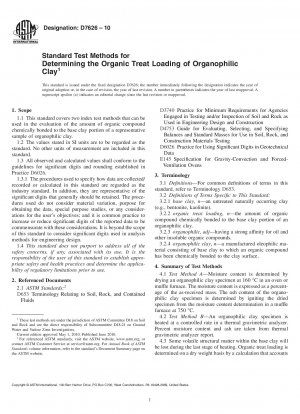ASTM D7626-10
Standard Test Methods for Determining the Organic Treat Loading of Organophilic Clay
- Standard No.
- ASTM D7626-10
- Release Date
- 2010
- Published By
- American Society for Testing and Materials (ASTM)
- Status
- Replace By
- ASTM D7626-19
- Latest
- ASTM D7626-19e1
- Scope
This standard test method is intended as an index test to determine the organic treat loading of organophilic clay. This standard test method can be used for manufacturing quality control and construction quality assurance material evaluation.
The percent organic treat loading of organophilic clay is a relative indicator of its adsorptive capacity. Organophilic clay is used for remediation of contaminated sediment, soil, and groundwater.
The two test methods denote different devices, a muffle furnace and a thermal gravimetric analyzer. The thermal gravimetric analyzer may be programmed to reach a higher temperature than the muffle furnace, but the organic matter will be burnt off at 750 °C.
Note 28212;The quality of the result produced by this standard is dependent on the competence of the personnel performing it, and the suitability of the equipment and facilities used. Agencies that meet the criteria of Practice D3740 are generally considered capable of competent and objective testing/sampling/inspection/etc. Users of this standard are cautioned that compliance with Practice D3740 does not in itself assure reliable results. Reliable results depend on many factors; Practice D3740 provides a means of evaluating some of those factors.
1.1 This standard covers two index test methods that can be used in the evaluation of the amount of organic compound chemically bonded to the base clay portion of a representative sample of organophilic clay.
1.2 The values stated in SI units are to be regarded as the standard. No other units of measurement are included in this standard.
1.3 All observed and calculated values shall conform to the guidelines for significant digits and rounding established in Practice D6026.
1.3.1 The procedures used to specify how data are collected/recorded or calculated in this standard are regarded as the industry standard. In addition, they are representative of the significant digits that generally should be retained. The procedures used do not consider material variation, purpose for obtaining the data, special purpose studies, or any considerations for the user’s objectives; and it is common practice to increase or reduce significant digits of the reported data to be commensurate with these considerations. It is beyond the scope of this standard to consider significant digits used in analysis methods for engineering design.
1.4 This standard does not purport to address all of the safety concerns, if any, associated with its use. It is the responsibility of the user of this standard to establish appropriate safety and health practices and determine the applicability of regulatory limitations prior to use.
ASTM D7626-10 Referenced Document
- ASTM D3740 Standard Practice for Minimum Requirements for Agencies Engaged in the Testing and/or Inspection of Soil and Rock as Used in Engineering Design and Construction
- ASTM D4753 Standard Specification for Evaluating, Selecting, and Specifying Balances and Scales for Use in Soil, Rock, and Construction Materials Testing
- ASTM D6026 Standard Practice for Using Significant Digits in Geotechnical Data
- ASTM D653 Standard Terminology Relating to Soil, Rock, and Contained Fluids
- ASTM E145 Standard Specification for Gravity-Convection And Forced-Ventilation Ovens
ASTM D7626-10 history
- 2019 ASTM D7626-19e1 Standard Test Methods for Determining the Organic Treat Loading of Organophilic Clay
- 2019 ASTM D7626-19 Standard Test Methods for Determining the Organic Treat Loading of Organophilic Clay
- 2010 ASTM D7626-10 Standard Test Methods for Determining the Organic Treat Loading of Organophilic Clay
